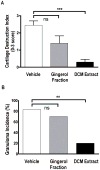Comparative effects of two gingerol-containing Zingiber officinale extracts on experimental rheumatoid arthritis
- PMID: 19216559
- PMCID: PMC2837120
- DOI: 10.1021/np8006183
Comparative effects of two gingerol-containing Zingiber officinale extracts on experimental rheumatoid arthritis
Abstract
Ginger (Zingiber officinale) supplements are being promoted for arthritis treatment in western societies on the basis of ginger's traditional use as an anti-inflammatory in Chinese and Ayurvedic medicine. However, scientific evidence of ginger's antiarthritic effects is sparse, and its bioactive joint-protective components have not been identified. Therefore, the ability of a well-characterized crude ginger extract to inhibit joint swelling in an animal model of rheumatoid arthritis, streptococcal cell wall-induced arthritis, was compared to that of a fraction containing only gingerols and their derivatives. Both extracts were efficacious in preventing joint inflammation. However, the crude dichloromethane extract, which also contained essential oils and more polar compounds, was more efficacious (when normalized to gingerol content) in preventing both joint inflammation and destruction. In conclusion, these data document a very significant joint-protective effect of these ginger samples and suggest that nongingerol components are bioactive and can enhance the antiarthritic effects of the more widely studied gingerols.
Figures


Similar articles
-
Pharmacokinetics and Tissue Distribution of Gingerols and Shogaols from Ginger (Zingiber officinale Rosc.) in Rats by UPLC⁻Q-Exactive⁻HRMS.Molecules. 2019 Jan 31;24(3):512. doi: 10.3390/molecules24030512. Molecules. 2019. PMID: 30708987 Free PMC article.
-
Revisiting the therapeutic potential of gingerols against different pharmacological activities.Naunyn Schmiedebergs Arch Pharmacol. 2023 Apr;396(4):633-647. doi: 10.1007/s00210-022-02372-7. Epub 2022 Dec 31. Naunyn Schmiedebergs Arch Pharmacol. 2023. PMID: 36585999 Free PMC article. Review.
-
Blood-brain barrier permeability study of ginger constituents.J Pharm Biomed Anal. 2020 Jan 5;177:112820. doi: 10.1016/j.jpba.2019.112820. Epub 2019 Aug 19. J Pharm Biomed Anal. 2020. PMID: 31476432
-
Gingerols of Zingiber officinale enhance glucose uptake by increasing cell surface GLUT4 in cultured L6 myotubes.Planta Med. 2012 Sep;78(14):1549-55. doi: 10.1055/s-0032-1315041. Epub 2012 Jul 24. Planta Med. 2012. PMID: 22828920
-
Zingiber Officinale Roscoe: The Antiarthritic Potential of a Popular Spice-Preclinical and Clinical Evidence.Nutrients. 2024 Mar 5;16(5):741. doi: 10.3390/nu16050741. Nutrients. 2024. PMID: 38474869 Free PMC article. Review.
Cited by
-
Immunomodulation of Autoimmune Arthritis by Herbal CAM.Evid Based Complement Alternat Med. 2011;2011:986797. doi: 10.1155/2011/986797. Epub 2010 Dec 22. Evid Based Complement Alternat Med. 2011. PMID: 21234398 Free PMC article.
-
A commercialized dietary supplement alleviates joint pain in community adults: a double-blind, placebo-controlled community trial.Nutr J. 2013 Nov 25;12(1):154. doi: 10.1186/1475-2891-12-154. Nutr J. 2013. PMID: 24274358 Free PMC article. Clinical Trial.
-
Anti-Inflammatory Effects of the Essential Oils of Ginger (Zingiber officinale Roscoe) in Experimental Rheumatoid Arthritis.PharmaNutrition. 2016 Jul;4(3):123-131. doi: 10.1016/j.phanu.2016.02.004. Epub 2016 Jun 4. PharmaNutrition. 2016. PMID: 27872812 Free PMC article.
-
Impact of NSAIDs corticosteroids DMARDs biologics and their comparisons with natural products in C-reactive proteins (CRP) linked cardiovascular disorders.Inflammopharmacology. 2025 May;33(5):2537-2563. doi: 10.1007/s10787-025-01767-1. Epub 2025 May 4. Inflammopharmacology. 2025. PMID: 40319427 Review.
-
γ-Tocotrienol and 6-Gingerol in Combination Synergistically Induce Cytotoxicity and Apoptosis in HT-29 and SW837 Human Colorectal Cancer Cells.Molecules. 2015 Jun 3;20(6):10280-97. doi: 10.3390/molecules200610280. Molecules. 2015. PMID: 26046324 Free PMC article.
References
-
- Barnes PM, Powell-Griner E, McFann K, Nahin RL. CDC Advance Data Report #343. 2004 May 27 - PubMed
-
- Ali BH, Blunden G, Tanira MO, Nemmar A. Food Chem Toxicol. 2008;46:409–420. - PubMed
-
- Chrubasik S, Pittler MH, Roufogalis BD. Phytomedicine. 2005;12:684–701. - PubMed
-
- Koo KLK, Ammit AJ, Tran VH, Duke CC, Roufogalis BD. Thrombosis Res. 2001;103:387–397. - PubMed
-
- Tjendraputra E, Tran VH, Liu-Brennan D, Roufogalis BD, Duke CC. Bioorgan Chem. 2001;29:156–163. - PubMed
Publication types
MeSH terms
Substances
Grants and funding
LinkOut - more resources
Full Text Sources
Other Literature Sources
Medical

